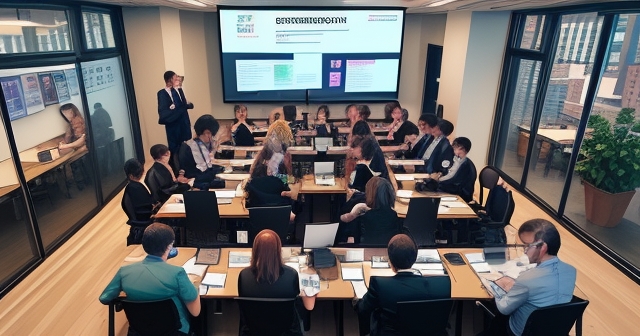Introduction: From Unicorn to Cautionary Tale
Imagine a company that captured the zeitgeist, promising not just office space, but community, culture, and a revolution in how we work. For a time, that company was WeWork. Founded in 2010 by Adam Neumann and Miguel McKelvey, it rapidly ascended the startup world, becoming the largest private office tenant in major cities globally and attracting billions in investment.

At its peak in early 2019, WeWork commanded a staggering private valuation of $47 billion, cementing its status as a seemingly unstoppable unicorn. Investors poured money into its vision of flexible, aesthetically pleasing co-working spaces that catered to everyone from freelancers to large corporations. The narrative was one of explosive growth and market disruption.
Yet, in a remarkably short span, this trajectory reversed with breathtaking speed. What followed was a dramatic downfall, culminating in a Chapter 11 bankruptcy filing in November 2023. How did a company valued at $47 billion lose virtually all its value and enter bankruptcy within just four years? This isn’t just a story of a failed business; it’s a complex case study revealing critical lessons about business models, leadership, governance, and the realities of rapid, venture-capital-fueled growth.
As investors and traders, we often focus on market movements and technical indicators. But understanding the fundamental forces that shape companies – their strategies, finances, and leadership – is equally crucial. The rise and fall of WeWork offers invaluable insights into the risks inherent in certain business models and the vital importance of transparency and prudent management. Let’s unpack this saga, step by step, to learn what went wrong and how we can identify similar warning signs in other ventures.
- WeWork was founded in 2010 by Adam Neumann and Miguel McKelvey.
- At its peak, WeWork’s valuation reached $47 billion.
- WeWork filed for Chapter 11 bankruptcy in November 2023.
The Vision and the Vertical Ascent: Building the “Community Company”
WeWork didn’t just offer desks and Wi-Fi; it sold an experience. Founders Adam Neumann and Miguel McKelvey envisioned a space that fostered collaboration and community, moving beyond the sterile, traditional office environment. They positioned WeWork not merely as a real estate company, but as a technology company, even a “community company” aimed at “elevating the world’s consciousness.”
This potent blend of attractive workspace, flexible terms, and a vibrant atmosphere struck a chord with the changing nature of work. Freelancers, burgeoning startups, and increasingly, large enterprises seeking adaptable solutions flocked to WeWork’s locations. Its spaces were designed to be visually appealing and functional, a stark contrast to typical drab office interiors.
The appeal translated into meteoric growth. WeWork embarked on an aggressive global expansion, securing long-term leases in prime real estate markets worldwide. Its footprint grew exponentially, making it a significant player in the commercial real estate landscape, notably becoming a major tenant in cities like Manhattan.

This rapid expansion and compelling narrative attracted enormous sums of venture capital. SoftBank, led by Masayoshi Son, became the most prominent investor, pouring over $8 billion into WeWork. This influx of capital acted as fuel for the company’s relentless growth engine, allowing it to acquire leases, build out spaces, and expand its operations at an unprecedented pace. The venture capital ecosystem, flush with “cheap capital,” eagerly backed WeWork’s ambitious vision, propelling its private valuation ever higher, culminating in that astonishing $47 billion figure.
From the outside, WeWork seemed unstoppable. Its brand was everywhere, its spaces were buzzworthy, and its valuation soared, embodying the ‘unicorn’ dream of rapid, disruptive success. But beneath the polished veneer and community events, significant challenges were taking root.
Cracks in the Foundation: Unpacking the Business Model’s Flaws
While WeWork marketed itself as a tech or community company, its core business model was fundamentally rooted in commercial real estate. The model involved taking out long-term leases (often 10-15 years) on large office buildings and then subletting smaller portions of that space on short-term, flexible memberships (monthly, annually). On the surface, this arbitrage seemed promising.
However, this model carried inherent risks and required substantial upfront investment. WeWork had to commit to years of rent payments, regardless of occupancy levels, while its revenue depended on members signing up and staying. Furthermore, each new location required significant capital expenditure for renovation, design, and build-out to create the signature WeWork aesthetic.
The company’s strategy was unequivocally “growth-first, profits later.” The focus was on increasing occupancy rates and opening new locations as quickly as possible, deferring profitability far into the future. This necessitated continuous, massive infusions of capital to cover operating expenses and expansion costs. While common in the tech startup world, this approach in the capital-intensive real estate sector created a voracious need for funding.
The financial reality behind the rapid expansion was stark. WeWork was accumulating substantial losses year after year. In 2018, it reported $1.9 billion in losses, followed by even larger losses exceeding $2 billion in 2019. This wasn’t a temporary dip; it was a structural outflow of cash driven by the core business model and aggressive spending.
Adding to the complexity, WeWork branched out into non-core businesses like WeLive (co-living spaces) and WeGrow (a private school). While perhaps aligning with the ‘community’ vision, these ventures diverted resources and attention without proving profitability or significantly bolstering the core business, further burdening the company’s finances.
This combination of a risky underlying business model, a relentless focus on growth over profitability, high upfront costs, and accumulating losses created significant pressure. The model was heavily reliant on sustained high occupancy rates and, crucially, on the continued availability of “cheap capital” from investors willing to fund losses in anticipation of future, hypothetical profits. This dependence on external funding sources made the company inherently fragile.
Questionable Governance and Leadership Under Adam Neumann
At the heart of WeWork’s culture and strategic direction was its charismatic, often erratic, co-founder, Adam Neumann. Neumann was a visionary salesman capable of inspiring employees and investors alike with his grand pronouncements and ambitious goals, like aspiring to be the world’s first trillionaire or believing WeWork could “elevate the world’s consciousness.”
However, Neumann’s leadership style and corporate culture were riddled with issues that would eventually come to light and alarm potential public investors. The culture was known for its excesses, including lavish corporate retreats like mandatory “Summer Camp” festivals featuring high costs, partying, and a blend of business updates with entertainment. This reflected a level of spending that seemed disconnected from financial discipline.
More concerning were instances of questionable governance and conflicts of interest. Neumann reportedly engaged in transactions that personally benefited him at the company’s expense. One notable example was trademarking the “We” brand name himself and then selling its usage rights to the company for $5.9 million (a transaction later reversed under pressure). He also invested in buildings that WeWork subsequently leased, raising concerns about self-dealing.
Decision-making often appeared centralized and based on personal interest rather than sound financial judgment. Rebekah Neumann, Adam’s wife, also held significant influence and was involved in leadership roles, including leading the WeGrow initiative, despite questions about her qualifications for certain positions.
The board of directors and internal governance structures seemed insufficient to check Neumann’s power or rein in spending and risky decisions. This lack of strong corporate governance meant that leadership decisions, even questionable ones, often went unchallenged, allowing the company to pursue a path that prioritized the founder’s vision and personal interests over prudent financial management and investor protection.
These internal issues – the culture of excess, conflicts of interest, and weak governance – were significant cracks developing beneath the surface of the high-flying startup. They represented a fundamental misalignment between the company’s operations and the principles of financial accountability, which would become starkly apparent when WeWork attempted to transition from private unicorn to public company.

The Reckoning: The Failed IPO and Investor Skepticism
The planned Initial Public Offering (IPO) in 2019 was intended to be WeWork’s crowning moment – its transition to a mature, publicly traded company, validating its stratospheric private valuation and providing liquidity for early investors and employees. However, the process proved to be the beginning of the end.
As part of the IPO process, WeWork had to file an S-1 registration statement with the U.S. Securities and Exchange Commission (SEC). This document provided the first truly transparent look at WeWork’s financials, business model, and governance structure to a broad audience of public investors.
What the S-1 filing revealed was deeply concerning to potential investors accustomed to the scrutiny and expectations of public markets. The document laid bare the massive, accumulating financial losses – billions of dollars with seemingly no clear path to profitability. It highlighted the fundamental structure of the lease-arbitrage business model, exposing its capital-intensive nature and reliance on high occupancy.
Furthermore, the S-1 shed an uncomfortable light on the company’s corporate governance issues and Adam Neumann’s control and controversial actions. Details about conflicts of interest, the multi-class stock structure that gave Neumann super-voting shares, and the general lack of checks and balances on the founder’s power raised significant red flags.
Public investors, unlike some venture capitalists who had bet heavily on the ‘growth-at-all-costs’ narrative, were far less willing to overlook the fundamentals. They “balked” at the revelations, questioning the disconnect between the astronomical $47 billion valuation and the underlying financial reality. The business model seemed unsustainable without continuous funding, and the governance issues were viewed as significant risks.
The skepticism and lack of appetite from public investors were undeniable. WeWork was forced to postpone its IPO, a humiliating blow. Despite attempts to address some concerns (like Neumann returning the money for the “We” trademark), confidence had been severely eroded. Eventually, the IPO was withdrawn entirely in September 2019.
The failed IPO was a pivotal moment. It burst the bubble of WeWork’s inflated valuation and exposed the company’s deep-seated financial and governance problems to the world. The venture capital fairy tale collided head-on with the harsh realities of public market scrutiny.

The Aftermath: Ousting the Founder and Valuation Plummet
The immediate consequence of the failed IPO was immense pressure on Adam Neumann. The investors, particularly SoftBank, who had poured billions into the company based on its perceived trajectory towards a successful public offering, lost faith in his leadership. The realization dawned that his management style and governance issues were not minor eccentricities but fundamental impediments to the company’s viability and public market acceptance.
In September 2019, just weeks after the IPO withdrawal, Adam Neumann was forced to step down as CEO. This marked a dramatic fall from grace for the charismatic figure who had been the face and driving force of the company. However, his departure was not without controversy. Reports indicated he received a significant “golden parachute,” a multi-million dollar severance package and stock deal, even as thousands of employees faced potential layoffs and saw their stock options become worthless.
With Neumann gone and the IPO dream shattered, WeWork’s private valuation plummeted with alarming speed. The $47 billion figure, once seen as a symbol of success, was now widely regarded as wildly unrealistic. Just eight months after its peak, by May 2020, WeWork’s valuation had dropped to a mere $3 billion – a catastrophic decline of over 93%. This rapid re-evaluation reflected the market’s harsh judgment on the company’s true worth once the hype was stripped away and the financials were scrutinized.
SoftBank, already WeWork’s largest investor, found itself in a difficult position. Having committed billions, they effectively took control of the struggling company. SoftBank injected more capital in an attempt to stabilize the situation and implement a turnaround strategy, but the losses on their investment were massive, amounting to billions of dollars.
Leadership changes were made, and efforts began to cut costs, streamline operations, and focus on the core business. However, the company was now burdened by its expensive long-term leases, significant debt, and a tarnished reputation. The task of turning around a company built on unsustainable growth and now facing market skepticism was monumental.
The period immediately following the failed IPO and Neumann’s exit was one of damage control and desperate attempts to right the ship. But external forces were about to deliver another, arguably more devastating, blow to WeWork’s already weakened structure.
COVID-19: The Pandemic’s Devastating Impact
Just as WeWork was attempting to recover from its internal crises and the fallout of the failed IPO, the world was hit by the COVID-19 pandemic in early 2020. This global health crisis triggered unprecedented lockdowns and fundamentally altered work patterns, delivering a critical blow to WeWork’s core business model.
As companies sent employees home to work remotely, the demand for physical office space, particularly flexible co-working spaces, evaporated almost overnight. WeWork’s locations, once bustling hubs of activity, became largely empty. Memberships were canceled or put on hold as businesses adapted to the new reality of working from anywhere.
The pandemic accelerated the existing trend towards remote and hybrid work. What might have been a gradual shift became a rapid transformation. Many companies realized that remote work was feasible and offered cost savings, leading them to re-evaluate their office needs. This structural change in the demand for office space directly undermined WeWork’s business, which was built on the assumption of consistent, growing demand for physical co-working locations.
WeWork was still saddled with billions in long-term lease obligations, a fixed cost structure that did not decrease even as revenue from memberships plummeted. This mismatch between fixed liabilities and collapsing revenue streams exacerbated the company’s already precarious financial situation. The losses mounted further, and the debt burden became increasingly unsustainable.
The pandemic didn’t *cause* WeWork’s problems – those were deeply rooted in its business model and governance – but it acted as a powerful catalyst, accelerating the inevitable outcome. It exposed the vulnerability of a model reliant on physical presence and consistent occupancy in the face of unforeseen market disruptions and changing work habits.
Despite efforts to adapt, such as offering more flexible plans or catering to enterprises needing satellite offices, the fundamental challenge remained: large-scale demand for shared physical space was significantly reduced. The pandemic made it clear that WeWork’s core offering, while innovative, was highly susceptible to economic downturns and societal shifts impacting office utilization.
Continued Struggles and the March Towards Bankruptcy
Even after Neumann’s departure and SoftBank’s intervention, WeWork continued to struggle. The efforts to turn the company around faced immense headwinds from the pandemic’s lingering effects on office occupancy and the heavy burden of expensive, long-term leases signed during the period of aggressive expansion.
Despite restructuring efforts, cost-cutting measures, and attempts to renegotiate leases, the company failed to achieve sustainable profitability or significantly reduce its debt load. Occupancy rates remained depressed in many locations, and the company continued to burn cash.
The financial reports continued to paint a grim picture, showing ongoing losses and a significant disparity between the company’s liabilities and assets. The initial billions invested by SoftBank and other venture capitalists were largely depleted, unable to sustain the company indefinitely in the face of structural challenges and diminished demand.
The path towards bankruptcy became increasingly apparent throughout 2022 and 2023. Despite attempts to raise additional funding or restructure its balance sheet through private deals, WeWork could not escape the weight of its debt obligations and its fundamentally challenged business model in the post-pandemic world.
Facing mounting pressure from creditors and unable to meet its financial obligations, WeWork ultimately had to seek legal protection to reorganize its affairs. This led to the filing for Chapter 11 bankruptcy protection in the United States in November 2023. This was a final admission that the company, in its current structure, could no longer operate solvently.
The bankruptcy filing revealed the extent of the financial distress. WeWork listed its debts soaring to $18.65 billion against its $15.06 billion in assets. This represented a significant shortfall, highlighting the scale of the financial collapse. The legal proceedings would aim to restructure the company, potentially shedding unprofitable leases and debt, but the outcome for many stakeholders, including remaining employees and junior creditors, was uncertain.
The bankruptcy filing marked the definitive end of the WeWork fairy tale, a dramatic fall from a $47 billion valuation to insolvency in just four years.
The Chapter 11 Filing: A Detailed Look at the Numbers
The filing for Chapter 11 bankruptcy protection on November 6th, 2023, provided the clearest official picture yet of WeWork’s dire financial state. While the company had been reporting losses for years, the bankruptcy documents solidified the scale of the problem.
Chapter 11 allows a company to continue operations while it reorganizes its business and debts under court supervision. For WeWork, this meant attempting to renegotiate leases, close unprofitable locations, and restructure its debt obligations in an effort to emerge as a smaller, potentially viable entity.
Below is a summary of WeWork’s financials during the Chapter 11 filing:
| Category | Amount |
|---|---|
| Debts | $18.65 billion |
| Assets | $15.06 billion |
The core issue laid bare in the filing was the significant disparity between WeWork’s financial commitments and its assets. The declared $18.65 billion in debts represented the culmination of years of accumulated losses, expensive long-term lease liabilities, and borrowings taken on to fuel expansion and cover operating costs. These were obligations that the company could no longer meet with its current revenue streams and asset base.
Against these massive debts, WeWork listed assets totaling $15.06 billion. While still a large number, this figure likely included the value of its remaining leasehold interests (though many were liabilities), property and equipment, and other intangible assets. The critical point was that the value of what the company owned was significantly less than what it owed, leading to insolvency.
This negative equity position was a direct result of the unsustainable “growth-first” model that prioritized rapid expansion at the expense of profitability and financial prudence. The billions in capital raised were burned through, invested in assets (like lease build-outs) that did not generate sufficient returns to cover the associated long-term liabilities, especially once market conditions soured.
The Chapter 11 process would involve complex negotiations with landlords (WeWork’s primary creditors), bondholders, and other stakeholders. The outcome would determine which leases are kept or rejected, how much creditors might recover, and whether any version of WeWork can survive. The process is a legal mechanism to manage an unwinding or significant restructuring when the traditional business model has failed and the company is unable to service its debts.
The bankruptcy filing wasn’t just a procedural step; it was the formal recognition of one of the most spectacular corporate collapses in recent history, a stark reminder of the consequences of unchecked ambition and financial imprudence.
Aftermath and Stakeholder Impact
The collapse of WeWork has had far-reaching consequences, impacting various stakeholders who were involved in the company’s journey, from its employees to its largest investors.
Employees: Thousands of WeWork employees faced uncertainty, layoffs, and the bitter reality that their stock options, once potentially valuable, became essentially worthless. The dream of sharing in the wealth of a successful IPO vanished, replaced by job insecurity and financial loss. The expensive corporate culture under Neumann, which included lavish events, seemed particularly galling in retrospect to those who lost their livelihoods.
Investors: SoftBank, as the largest investor, suffered billions in losses. Their ambitious investment in WeWork, part of a broader strategy to back ‘disruptive’ tech companies at high valuations, became one of their most significant and costly failures. Other venture capital firms and early investors also saw their investments severely written down or wiped out entirely. The saga highlighted the risks inherent in late-stage venture investing when valuations become detached from fundamental financial performance.
Landlords: Many commercial real estate landlords who leased space to WeWork faced uncertainty. The bankruptcy process allowed WeWork to potentially reject leases for unprofitable locations, leaving landlords with vacant space and potentially unrecoverable rent. This added stress to a commercial real estate market already facing challenges from the remote work trend.
The Startup Ecosystem: The WeWork story became a cautionary tale for the broader startup ecosystem and venture capital world. It raised questions about the sustainability of the ‘growth-at-all-costs’ mantra, particularly for capital-intensive businesses. It also sparked debates about the role of founder control, the importance of independent corporate governance, and the need for realistic valuations based on a clear path to profitability, not just hype and potential market disruption.
The Co-working Industry: While WeWork’s financial failure was monumental, the company is credited with popularizing the co-working concept and significantly influencing modern office design. The demand for flexible office solutions still exists, although the market has matured and diversified, with competitors offering various models. WeWork’s collapse didn’t kill co-working, but it certainly reshaped perceptions and highlighted the need for more financially sound operations in the sector.
The ripple effects of WeWork’s implosion extend beyond the immediate financial losses, forcing a re-evaluation of investment strategies, corporate governance standards, and the very definition of a sustainable business in the age of rapid digital and societal change.
Identifying Red Flags: What Investors Can Learn
The WeWork saga, while dramatic, offers critical lessons for investors and business leaders alike. Understanding these takeaways can help you identify similar warning signs in other companies, whether public or private.
- Unrealistic Valuations: A valuation must be grounded in fundamental financial performance and future potential, not just hype or market speculation. Be wary of companies whose valuations seem vastly disconnected from their revenue, profitability, and cash flow generation. Ask how the valuation is justified and what realistic assumptions are being made about future growth and margins.
- Unsustainable Business Models: Models that require continuous, massive injections of capital without a clear, credible path to profitability are inherently risky. A ‘growth-first, profits later’ strategy is only viable if there is a strong underlying mechanism for eventually achieving significant scale economies and positive cash flow. WeWork’s lease-arbitrage model proved difficult to scale profitably due to fixed costs and market volatility.
- Poor Corporate Governance: Look for strong, independent boards of directors that can provide oversight and challenge executive decisions. Be cautious of companies where a single founder or small group holds excessive control through super-voting shares or a compliant board. Conflicts of interest and related-party transactions are major red flags.
- Excessive Spending and Lack of Financial Discipline: High-growth startups often spend heavily, but there should be evidence of fiscal responsibility. Lavish corporate events, investments in unrelated side ventures, and a general disregard for cost control can signal deeper management issues and accelerate cash burn.
- Over-reliance on External Funding: While startups need funding, excessive dependence on raising capital to cover operating losses makes a company vulnerable to shifts in investor sentiment or market conditions (like the availability of “cheap capital”). A healthy business generates cash internally or has a clear path to doing so.
- Transparency and Reporting: Scrutinize financial statements and disclosures carefully. Look for clarity in how key metrics are defined and reported. The S-1 filing, while ultimately fatal to WeWork’s IPO, served its purpose by forcing transparency and allowing public investors to make informed decisions based on facts, not just marketing.
As investors, you don’t need to be insiders to spot some of these red flags. Paying attention to how a company talks about its financials, the behavior of its leadership, and the plausibility of its business model can provide crucial insights. WeWork wasn’t just a failure of execution; it was a failure rooted in fundamental strategic and governance choices.
WeWork’s Legacy: Reshaping the Office and Lessons for the Future
Despite its dramatic financial failure and bankruptcy, it would be inaccurate to say WeWork had no positive impact or lasting legacy. In many ways, WeWork fundamentally reshaped perceptions of the office environment and accelerated trends towards flexibility that were already nascent.
WeWork’s spaces were designed with aesthetics and collaboration in mind, moving away from the drab cubicle farms of the past. They popularized features like open layouts, comfortable lounges, well-designed meeting rooms, and amenities such as coffee bars and event spaces. This design philosophy influenced not only other co-working providers but also traditional companies redesigning their own offices to foster creativity and community.
Furthermore, WeWork played a significant role in normalizing and popularizing the co-working concept for a wide range of users, from solo entrepreneurs to divisions of large corporations. They demonstrated that businesses of all sizes could benefit from flexible lease terms and shared amenities, challenging the long-held assumption that companies needed traditional long-term office leases for all their space needs.
While the company’s financial model proved unsustainable, the demand for flexible office solutions remains. The post-pandemic world, with its emphasis on hybrid work, has actually increased the need for flexible arrangements, albeit perhaps different ones than WeWork initially envisioned. WeWork’s influence is visible in the continued growth of the flexible office market, albeit with operators now hopefully prioritizing profitability and sustainable structures.
For businesses and executives, the most valuable legacy might be the harsh lessons learned. The WeWork story underscores the need for:
- Data-driven decisions: Relying on hype and intuition over financial data is perilous.
- Sustainable business models: Growth is only valuable if it leads to eventual profitability and positive cash flow.
- Professional advice: Independent financial and governance expertise is not optional.
- Realistic valuations: Valuations must be tied to fundamentals and market realities.
- Prudent budget planning: Unchecked spending can sink even a rapidly growing company.
The WeWork saga is a powerful reminder that even the most charismatic leadership and disruptive vision cannot overcome fundamental business model flaws and a lack of financial and governance discipline. It serves as a stark illustration of the potential pitfalls when venture capital fuel meets an engine not built for long-term efficiency and sustainability.
Conclusion: Lessons from the Fall for Your Investment Journey
The journey of WeWork, from a $47 billion valuation giant to a company filing for bankruptcy protection, is one of the most compelling and cautionary tales in modern business history. It’s a story of ambition, innovation, hype, and ultimately, a dramatic collision with reality.
We’ve seen how a captivating vision and rapid expansion fueled by enormous venture capital could create the illusion of invincibility. But we’ve also uncovered the critical flaws: a fundamentally challenging business model heavily reliant on constant funding and high occupancy, a culture of excess, significant governance issues, and leadership decisions that seemed at odds with financial prudence.
The attempted IPO acted as a harsh truth serum, exposing these underlying problems to a skeptical public market. This, combined with the unforeseen impact of the COVID-19 pandemic accelerating the shift to remote work, delivered the final blow to an already weakened structure. The outcome was inevitable: a massive loss of value and the descent into bankruptcy, leaving a trail of financial damage for employees, investors, and creditors.
For you, as an investor or someone seeking to deepen your understanding of markets and companies, the WeWork story offers profound insights. It teaches us that:
- High valuations don’t guarantee success; they can merely reflect hype.
- A compelling narrative is no substitute for a sustainable business model.
- Strong corporate governance and ethical leadership are essential for long-term viability.
- External market shifts and unforeseen events can rapidly expose fundamental weaknesses.
While WeWork’s saga is rooted in the world of startups and real estate, the principles are universal. The need for transparent financials, sound management, realistic expectations, and adaptable strategies applies to companies in any sector.
By dissecting cases like WeWork, we gain a richer understanding of the forces that can drive companies to extraordinary heights and equally spectacular failures. This knowledge, combined with your analysis of market data and technical indicators, strengthens your overall investment approach, helping you navigate the complexities of the financial world with greater wisdom and foresight.
rise and fall of weworkFAQ
Q:What led to WeWork’s initial rapid growth?
A:WeWork capitalized on the demand for flexible co-working spaces and received significant venture capital backing.
Q:How did governance issues impact WeWork?
A:Weak governance and conflicts of interest under Adam Neumann led to risky decisions and maladaptive company practices.
Q:What was the result of WeWork’s failed IPO?
A:Investor skepticism led to the withdrawal of the IPO, triggering a rapid decline in valuation and eventual bankruptcy.

留言